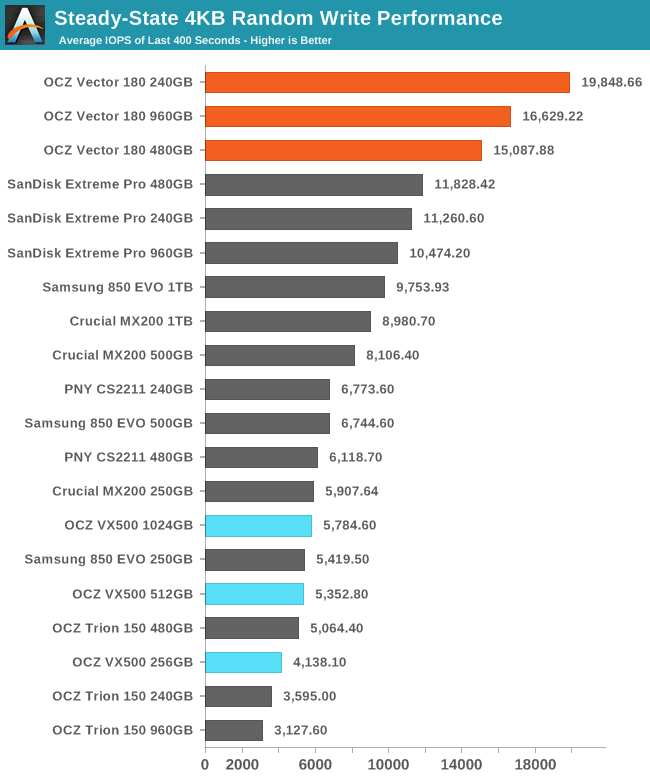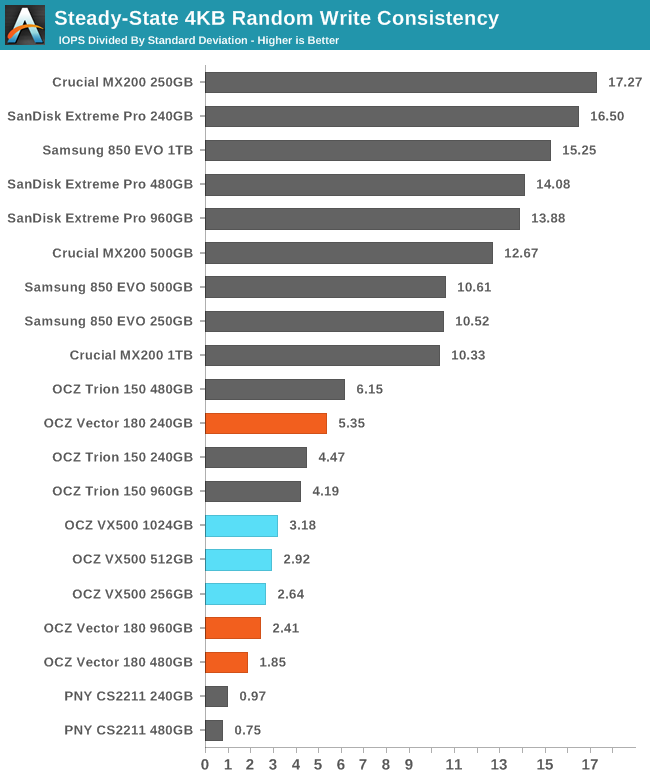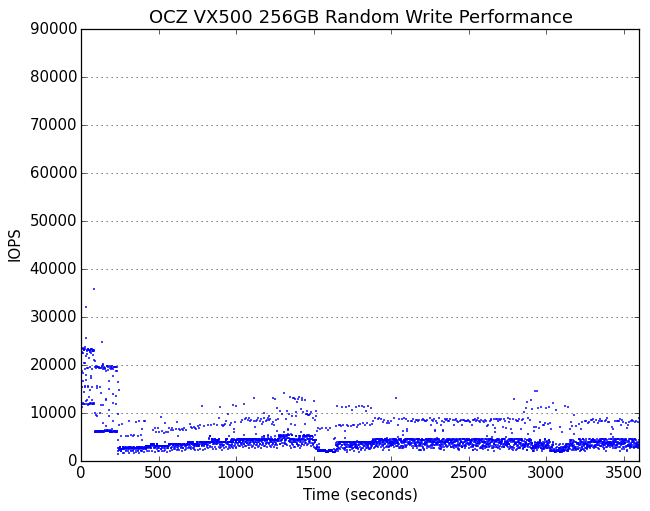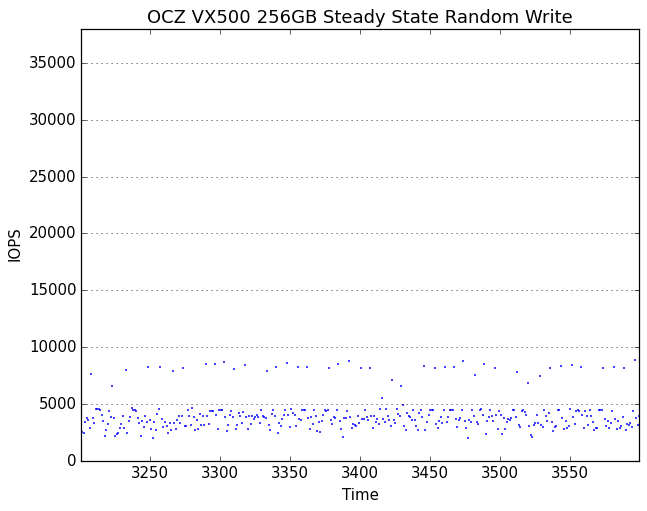The Toshiba OCZ VX500 (256GB, 512GB, 1024GB) SSD Review
by Billy Tallis on September 13, 2016 9:00 AM ESTPerformance Consistency
Our performance consistency test explores the extent to which a drive can reliably sustain performance during a long-duration random write test. Specifications for consumer drives typically list peak performance numbers only attainable in ideal conditions. The performance in a worst-case scenario can be drastically different as over the course of a long test drives can run out of spare area, have to start performing garbage collection, and sometimes even reach power or thermal limits.
In addition to an overall decline in performance, a long test can show patterns in how performance varies on shorter timescales. Some drives will exhibit very little variance in performance from second to second, while others will show massive drops in performance during each garbage collection cycle but otherwise maintain good performance, and others show constantly wide variance. If a drive periodically slows to hard drive levels of performance, it may feel slow to use even if its overall average performance is very high.
To maximally stress the drive's controller and force it to perform garbage collection and wear leveling, this test conducts 4kB random writes with a queue depth of 32. The drive is filled before the start of the test, and the test duration is one hour. Any spare area will be exhausted early in the test and by the end of the hour even the largest drives with the most overprovisioning will have reached a steady state. We use the last 400 seconds of the test to score the drive both on steady-state average writes per second and on its performance divided by the standard deviation.

No consumer SATA drive sustains better random write IOPS than the Vector 180, while the VX500 is slower than most MLC drives.

The Barefoot 3 controller wasn't great for consistency in spite of its high overall performance, so the Vector 180 and VX500 end up with relatively similar scores, and both have lots of room for improvement.
 |
|||||||||
| Default | |||||||||
| 25% Over-Provisioning | |||||||||
The VX500 goes through two distinct performance phases before reaching steady-state. During those early phases it maintains relatively good minimum performance, in stark contrast to the severe stuttering the Vector 180 showed throughout this test, especially for the larger capacities.
With extra manual overprovisioning, the VX500 goes through several more phase transitions but always maintains decent performance.
 |
|||||||||
| Default | |||||||||
| 25% Over-Provisioning | |||||||||
The steady state write performance of the VX500 is confined mostly to a band around 3k-5k IOPS with frequent outliers up to about twice that speed. With extra overprovisioning, the steady state is clearly better than that of the Phison-based PNY CS2211 but not as fast or consistent as the flagship MLC drives from Samsung and SanDisk.










29 Comments
View All Comments
Lolimaster - Tuesday, September 13, 2016 - link
LOL $337? You can get 1TB and 1 500GB Crucial MX500 with just a few more bucks.Lolimaster - Tuesday, September 13, 2016 - link
MX3002016, still no edit button, GG.
sonicmerlin - Tuesday, September 13, 2016 - link
Feels like SSD prices/GB have been pretty stagnant the last couple years.rhysiam - Wednesday, September 14, 2016 - link
They have dropped significantly. Check out the price table from the 850EVO launch review which was less than two years ago. Cheapest $/GB drive was the 240GB ARC 100 @ 42c/GB. That table in this article has a bunch of drives cheaper than that, and it's mid-range SATA drives. There are entry level 480GB drives going today that are only $10 more than the budget 240GB drives from less than two years ago.I'd call that pretty reasonable progress on the $/GB front.
rhysiam - Wednesday, September 14, 2016 - link
Here's the table from the 850EVO launch review: http://www.anandtech.com/show/8747/samsung-ssd-850...sonicmerlin - Wednesday, September 14, 2016 - link
The EVO was always higher priced. Look at the average prices:https://pcpartpicker.com/trends/price/internal-har...
They've come down, but not as dramatically as before. I remember well over a year ago being able to buy a SDD for 25 cents/GB on a good deal, and now it's about 20 cents/GB. Perhaps it's because of the slow transition to 3D NAND, but I'm hoping the pace picks up again.
Hiniberus - Wednesday, September 21, 2016 - link
When will these go on sale? I'm curious about them but I can't find any store that has them in stock!superunknown98 - Friday, September 23, 2016 - link
I don't really understand the final words giving the drive praise. It didn't seem to perform that much better compared other drives, including it's predecessor. Even in ATSB-Destroyer it had middling performance with good power consumption.cargostud - Thursday, February 2, 2017 - link
I had a VTR1-25SAT3-512G with a 5 year Warranty. It has 4k Random Write: 95K IOPS; 4k Random Read: 100K IOPS according to the specs. It died a few weeks ago and it is being replaced with a VX500. It has a spec of 4k Random Write: 64K IOPS; 4k Random Read: 92K IOPS. The replacement drive is slower than the one I had before. Wouldn't a more fair replacement be a VT180? 4k Random Write: 90K IOPS; 4k Random Read: 90K IOPS